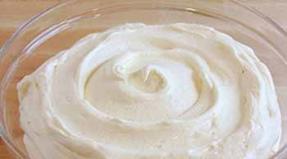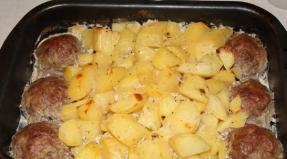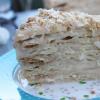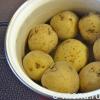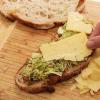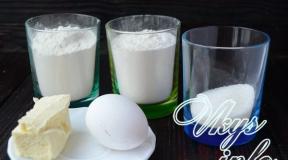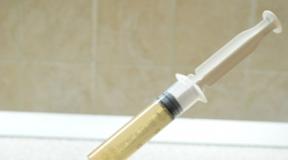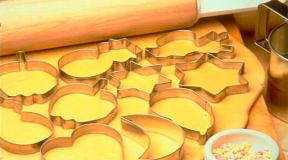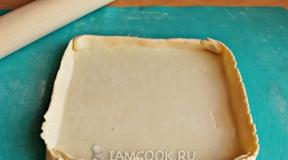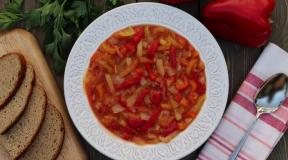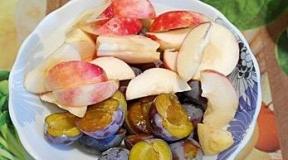Is it possible to ferment cabbage in a plastic bucket? Sauerkraut recipe in a plastic bucket. Sauerkraut for the winter - vitamin reserves
Foreword
Sauerkraut for the winter is one of the most delicious, healthy and popular pickles. They love it as a separate dish and without it it is impossible to cook some others really tasty (vinaigrette, cabbage soup, etc.). Sauerkraut is healthier than fresh - it not only retains all the vitamins and trace elements present in the vegetable cut from the garden, it also adds active healing substances formed during the fermentation of the product.
Of course, you can ferment absolutely any cabbage. However, in order to prepare a truly delicious dish, you should follow some recommendations for choosing this vegetable. First of all, it should be noted which is best. Moreover, not every variety is suitable, and when buying or choosing a head of cabbage cut from the garden, you need to pay attention to its appearance.
You should use medium late, and better late varieties of white cabbage. The early ones are worse in that their heads are loose and with a much lower sugar content, which is necessary not only for a good taste of the preparation, but also for fermentation during fermentation. Therefore, the best period for souring cabbage is mid-late autumn, when the forks of the later varieties of this vegetable ripen and acquire the required density.
You should only choose really well-ripened forks - they will contain sufficient sugar. It is best to take larger heads of cabbage, slightly flattened and almost pure white. Their impressive size will indicate sufficient maturation. However, the head of cabbage should not be too large either. Firstly, it will not be very convenient to cut it, and secondly, it is possible that such a vegetable was "fed" with fertilizers that accelerated its growth.
When choosing forks, you need to pay attention to the upper outer leaves covering them. They should be light green in color. If it is almost white, then, most likely, the heads of cabbage were frozen, and the seller, wanting to hide it, removed the top leaves.
The stump should be free from damage and signs of rot, dense and white. The leaves should be free of any blotches, spots and holes. The smell of the head of cabbage should be fresh and vegetable. If it smells like rot, you need to choose a different forks.
The choice of dishes for fermentation
The best dish for pickling any vegetables is wooden. Previously, oak barrels or tubs were used. If the cabbage is fermented in such a container, then it will additionally acquire a pleasant aroma and taste.
A worthy replacement for oak crockery is enamel. An important condition for its use is that the enamel on the entire inner surface of the container should not have any chips or cracks. You can use enamelled cisterns, pots and even buckets. Clay containers are also suitable.

If there is a basement or cellar, it is imperative to take dishes of impressive size. Only in large quantities can you really ferment cabbage really well.
Steel, aluminum and plastic containers are completely unsuitable.
The lactic acid released from sauerkraut and the brine itself will react with metal or plastic. Because of this, the workpiece will have an unpleasant aftertaste, and the formation of harmful and even dangerous substances may also occur.
When there is no basement or cellar and you have to ferment cabbage in the apartment, it is best to use glass jars. Their volume must be at least 3 liters.
Ingredients and their ratio
The main ones are cabbage, carrots and salt. We take as much cabbage as we are going to ferment. Carrots - at your own discretion. It gives sauerkraut a sweetish pleasant aftertaste and makes it more aromatic, juicy and crunchy, and the appearance of the dish served on the table is more attractive. In the classic recipe for carrots, take 1 kg per 10 kg of cabbage and that's enough. But more is possible, as is suggested in various other cooking options. Too many carrots will overpower the flavor of the cabbage.
Salt is a separate topic. The main thing is that it should be no more than 25 g per 1 kg of vegetables. Otherwise, it will not be fermentation, but salting. The second requirement for salt is that it must be non-iodized. It is better to use coarse, but fine grinding is also possible. Iodized salt will make cabbage not very tasty, not so crispy and can become unpleasant to eat - slippery.

You can ferment cabbage with the addition of various spices and seasonings: dill seeds, bay leaves, black pepper, cloves, horseradish and others. They will give the workpiece a pleasant aroma and piquant taste. However, you have to be careful with adding them. If you overdo it, the spices will overpower the natural flavor of the cabbage.
Sugar is often added, especially if the cabbage is immature or still of early varieties. They take it, as a rule, in the same proportions as salt - up to 25 g per 1 kg of vegetables. Firstly, sugar improves fermentation, and, secondly, sauerkraut with it turns out to be more pleasant and delicate in taste, sometimes even sweetish, and also less sour.
Some people ferment cabbage with fruits and / or berries, for example, plums, apples, lingonberries, cranberries. These ingredients give the piece a pleasant, sour taste. You can add beets. The cabbage will acquire a ruby color and an unusual taste.
How to cut vegetables properly
You can ferment the whole cabbage by dividing the head of cabbage in half or into several parts, cutting the leaves into large or small squares, triangles or rectangles, and chopping it into narrow strips. The latter option is most often used. So the vegetable ferments faster and more evenly. Moreover, it is necessary to chop quite finely, but it is also not worth chopping too much. Otherwise, the sliced pieces will soften during fermentation and the cabbage will turn into porridge, it will not be crispy.
You can shred with a sharp knife. Even better - a special shredder designed for chopping cabbage. With its help, this vegetable will be cut correctly and quickly.

It is strongly not recommended to use a grater for chopping heads of cabbage. The pieces of leaves will turn out to be too small and crushed, they will no longer be crispy and juice will come out of them prematurely.
Carrots, regardless of the recipe, can be grated on a regular grater with large or medium cells. Often they use Korean-style carrots.
If according to the recipe it is necessary to add other products, then the berries are left intact, the plums too, or they are cut in half, but in any case the seeds are removed. and the beets are cut at your discretion: in half, into several parts or in slices, plates. Small and small are best left intact.
Methods and temperature conditions for fermentation
There are two main methods, conventionally called wet and dry. In the first case, cabbage is mixed with carrots and spices when they are used, and then placed tightly in a fermentation container or layered in it with other products (apples, berries, or others), if they are in the recipe. Then everything is poured with boiled brine, cooled or hot. If sugar is added, it is dissolved along with the salt during the boil.
Taking the dry method as the basis of the recipe, first mix the cabbage or even grind it with salt and mash a little so that it gives juice. Then mix with carrots. This is usually done in an enamel cup in portions. Take 1 proportional part of cabbage, salt and carrots, mix them and put them in a fermentation container, tamping them as shown in the video. Then they also do with the following portions. In parallel, other products (apples, berries or others) are placed in a container in layers, if they should be. Cabbage is not poured with water or brine, but fermented in its own juice, which is released during fermentation.

If the recipe requires sugar or spices, add them while stirring the cabbage with carrots. You should not crush and tamp vegetables strongly, otherwise the workpiece will not turn out crispy.
Regardless of the method and recipe for fermentation, the next thing to do is to cover the cabbage with clean gauze or a cloth and press down with oppression (load). To do this, a suitable size enamel lid or plate is placed on it in a wide container, and a load is placed on top - a washed natural stone or a jar of water. Metal objects will not work. If cabbage is fermented in a jar, then you can put nothing at all or use a small jar of water.

The first few days - usually three days, sometimes more - the cabbage should be fermented at room temperature. During this period of harvesting, constant monitoring is needed for the vegetable. It is necessary to regularly skim off the foam from fermentation and pierce the cabbage in several places with a clean wooden kitchen appliance to allow the gases to escape. If you do not do all this, then you can forget about a tasty, and even more so, crispy appetizer. The workpiece will turn out to be bitter and soggy.
When the foam ceases to stand out, and the brine brightens, you can already eat the cabbage, although it is still not fermented. The container with it must be placed in a dark, cool place. Better in the cellar, and in the absence of that, you can go to the refrigerator. To ferment completely, the cabbage must stand there for about a month. And then it is stored there for up to 9 months. The optimum temperature for further fermentation and subsequent storage is 0– + 2 o C.
Almost every housewife in the fall makes preparations from vegetables. White cabbage is especially popular. It can be served as an independent dish or as a side dish. There are many recipes for keeping sauerkraut tasty and juicy for the winter.
Sauerkraut for the winter - a classic recipe
An old blank, which was made for the winter by our mothers and grandmothers. Crunchy springy cabbage will become your family's favorite dish.
Ingredients:
- white cabbage - 1.2 kg;
- carrots - 400 g;
- table salt - 55 g.
Preparation:
- Separate 2-3 top leaves from the head of cabbage, chop the rest into thin strips. Pour into an enamel basin.
- Rinse the carrots in cool water, peel, grate, place in a container for the cabbage.
- Stir vegetables gently with salt.
- Rinse the enamelled container with warm water. Pour in chopped vegetables, tamp with a wooden pestle for 11-13 minutes until cabbage juice forms.
- Press on top with a wide plate. Put down oppression. Place in a dark place to start fermentation.
- Remove oppression daily and pierce the cabbage with a long knitting needle. Fermentation takes 6 to 8 days.
- Transfer the pickled vegetables to voluminous pots, which are placed in the basement or glacier.
Recipe in brine with vinegar



Delicious spicy dish perfect for savory food aficionados.
Ingredients:
- white cabbage - 1.3 kg;
- carrots - 330 g;
- water - 1 l;
- garlic - 4 cloves;
- granulated sugar - 95 g;
- salt - 3 tablespoons;
- vegetable oil - 90 g;
- apple cider vinegar - 90 g;
- pepper - 4 peas;
- bay leaf - 2 pieces.
Preparation:
- To make brine liquid, heat the water. Stir oil, salt, sugar, laurel, pepper in it.
- Chop the cabbage into thin strips 3 - 5 cm long.
- Rinse the carrots with a stream of warm water, chop.
- Stir cabbage with carrots. Crumple until drops of juice appear.
- Peel the garlic, chop into thin squares.
- Add garlic and vinegar to the chilled brine. Bring it to a boil.
- Transfer vegetables to a glass container, pour boiling brine.
- Remove the jar in a dark place for 25 - 27 hours.
Serve the finished dish with mashed potatoes or meat patties.
Hot sauerkraut

Sometimes there is no time to wait for the cabbage to ferment. The hot cooking method allows you to enjoy a crispy side dish in the near future.
Ingredients:
- white cabbage - 2.6 kg;
- carrots - 350 g;
- water - 1.4 l;
- granulated sugar - 2 tablespoons;
- salt - 2 tablespoons.
Preparation:
- Free the head of cabbage from the outer leaves, chop into thin strips.
- Rinse the carrots, peel, chop into long thin bars.
- Stir cabbage and carrots in a cup. Place in a clean enamel container.
- Heat the water, add salt and sugar.
- Pour the prepared hot brine over the cabbage. Put oppression made of plastic or wood, remove the container in a shaded place for 18 - 21 hours.
Hot-fermented cabbage is ideal with roasted beef and seafood stew.
How to ferment cabbage in your own juice



A healthy and simple dish. Cabbage is ideal for adding to cabbage soup, stewing with meat and serving as a side dish.
Ingredients:
- carrots - 250 g;
- salt - 1.5 tablespoons.
Preparation:
- Cut the head of cabbage into pieces, separating the stalk. Chop each piece with a special knife. Mash the cabbage in the palm of your hand until the juice appears, put in a basin.
- Wash the carrots with cool water and grate.
- Put a layer of cabbage 2.5-3 cm thick in a large bowl. Pour grated carrots 0.5-1 cm thick on top. Pour in a pinch of salt.
- Lay vegetables, pressing each layer firmly.
- Press down on top of the container with a plate and press down. Wait until the juice is released from vegetables.
- After 21 - 23 hours, the fermentation process will begin in the brine. It is necessary to remove the oppression every day and pierce the workpiece with a thin skewer.
- Keep the bowl in a warm place for 4-6 days. Put the finished cabbage in a glass container, tamp it, put it in the basement.
If the head of cabbage was not very juicy and did not release enough liquid, then it is necessary to add 1-2 glasses of warm water.
Cooking with apples

Apples will add a piquant aftertaste and pleasant tart aroma to the dish.
Ingredients:
- white cabbage - 2.2 kg;
- carrots - 360 g;
- green apples - 5 pieces;
- salt - 75 g;
- granulated sugar - 75 g;
- peppercorns - 17 pieces.
Preparation:
- Rinse cabbage and carrots in warm water, grate.
- Mix carrots, cabbage, salt, granulated sugar, pepper.
- Wash the apples with cool water, remove the seeds. Cut into cubes or sticks.
- Rinse the glass container under running cool water, sprinkle the cabbage layer on the bottom. Put a layer of apples on top. Tamp down firmly. Alternate layers until 3 - 5 cm remains on top. This place must be left empty for the resulting juice.
- Cover the jar with a lid and place in a dark, warm place for 2-3 days. Pierce the cabbage 3 times daily with a thin knife or fork to release fermentation gases.
- After 3 days, put the jar in a cool place for 6-9 days.
Free cabbage from excess liquid before serving.
Sauerkraut with beets
A unique recipe will add an extravagant burgundy hue to the dish. Cabbage will be a wonderful decoration for festive dishes.
Ingredients:
- white cabbage - 2.4 kg;
- carrots - 230 g;
- beets - 120 g;
- salt - 30 g;
- black pepper - 9 peas;
- bay leaf - 1 piece;
- rye bread rusks - 15 g.
Preparation:
- Put rye rusks on the bottom of the ceramic barrel to speed up fermentation. Cover with a large cabbage leaf.
- Finely chop the cabbage.
- Rinse carrots and beets under running hot water, peel and grate.
- Pour chopped vegetables into a large basin and gently mash until juice forms.
- Transfer the cabbage to a bucket, tamp it hard. Place a plastic circle on top and press down.
- After the cabbage has settled and the brine has formed, pierce the vegetables with a long fork every 8-11 hours.
- Cooking time: 2-3 days.
- To stop fermentation, put the cabbage in the cold. Can be transferred to glass jars and stored in the basement.
Cabbage is served with kebabs and baked vegetables. Can be supplemented with potato garnish.
With horseradish and pepper for the winter

A vigorous and spicy dish is instantly eaten at a large feast. Ideal as a snack for men.
Ingredients:
- Bulgarian pepper - 0.4 kg;
- carrots - 4 pieces;
- horseradish root 60 g;
- garlic - 7 cloves;
- water - 1 l;
- granulated sugar - 110 g;
- salt - 1.5 tablespoons;
- vinegar 9% - 100 g;
- vegetable oil - 100 g;
- black pepper - 4 peas.
Preparation:
- To prepare the marinade, add salt, sugar, pepper to cool water, stir and bring the liquid to a boil. Add bite, remove liquid from stove.
- Free the head of cabbage from the outer leaves, taking out the stump, and chop into strips.
- Rinse the pepper in cool water, free from seeds, chop into small strips.
- Rinse the carrots, peel and grate.
- Wash the horseradish thoroughly, pass in a blender until a mushy mass.
- Peel the garlic, cut into small squares.
- Stir all vegetables and transfer to a glass container. Tamp with a wooden mortar, pour over warm marinade.
- Cover the container with a lid, put it in a dark place. The cabbage will cook in 4-5 days.
To add a spicy aroma, you can put currant or cherry leaves in the marinade.
An easy way to make crispy sauerkraut



An up-to-date and uncomplicated recipe, even a young housewife can handle it.
Ingredients:
- white cabbage - 2.8 kg;
- carrots - 2 pieces;
- granulated sugar - 65 g;
- salt - 85 g;
- bay leaf - 3 pieces;
- water 2.3 l.
Preparation:
- Pour water into a bowl, stir it with granulated sugar, salt. Put the laurel. Boil for 2-3 minutes.
- Rinse cabbage and carrots and chop into thin strips. Knead gently until juice appears.
- Pour 0.6 l of brine into a jar and put the cabbage. Tamp with a wooden mortar or spoon.
- If there is still room for the brine, then add liquid.
- Remove the jar in a warm place for 3-4 days.
The best storage place is a dark closet or on a loggia.
Korean cabbage for the winter

This spicy dish will be appreciated by lovers of oriental cuisine.
Ingredients:
- cauliflower - 900 g;
- carrots - 280 g;
- garlic - 8 cloves;
- ground red pepper - 2.2 g;
- ground cardamom - 2.2 g;
- ground cloves - 2.2 g;
- vinegar 9% - 90 ml;
- salt - 23 g;
- vegetable oil - 90 ml.
Preparation:
- Rinse the cabbage, stratify into inflorescences.
- Pour the inflorescences into a saucepan, cover with warm water and simmer for several minutes.
- Place vegetables in a colander to drain off excess liquid.
- Rinse the carrots, peel and grate.
- Peel the garlic, chop into small squares.
- Put salt, oil and vinegar in the water, stir everything and boil for 6-8 minutes.
- Stir cabbage with carrots and chopped garlic. Sprinkle with spices.
- Put vegetables in a glass container, pressing firmly with a mortar.
- Cover with boiling brine. Place the jars in warm water and sterilize for 12-14 minutes. Roll up with a typewriter.
- Place closed jars with their bottoms up, cover with a woolen blanket for a couple of hours.
Store Korean-style cabbage in any dark place.

This traditional Georgian dish is original and spicy. Ideal with grilled lamb and pork.
Ingredients:
- white cabbage - 900 g;
- carrots - 90 g;
- beets - 90 g;
- garlic - 7 cloves;
- water - 1 l;
- granulated sugar - 0.5 cups;
- salt - 3 tablespoons;
- hot pepper - 1 piece;
- vinegar 9% - 90 g.
Preparation:
- Chop the cabbage into 4-6 cm pieces.
- Rinse and peel the beets and carrots. Chop the beets into strips 2-3 cm long. Grate the carrots.
- Peel the garlic, divide each slice in half.
- Chop the chili finely, removing the seeds.
- Pour water mixed with vinegar, salt, sugar into a saucepan. Bring the liquid to a boil.
- Stir in cabbage, beets, carrots, garlic and chili. Put in a sterile container, be good at it.
- Pour vegetables with warm brine, remove in a dark place for 16-19 hours.
At a temperature of 16-18 degrees, cabbage is stored for 29-32 hours. To increase the shelf life, it is recommended to put it in a cellar or glacier.
Sauerkraut with cranberries

Cabbage with cranberries is a traditional Russian food. She was an integral part of the royal table, along with eggplant caviar and salted mushrooms.
Ingredients:
- white cabbage - 1.8 kg;
- carrots - 1.5 pieces;
- fresh cranberries - 160 g;
- salt - 3 tablespoons;
- granulated sugar - 3 tablespoons;
- bay leaf - 2 pieces.
Preparation:
- Rinse the cranberries in warm water.
- Free the cabbage from the top leaves, chop into small strips.
- Rinse the carrots, peel, grate.
- Mix cabbage and carrots, sprinkle with sugar and salt.
- Put the cabbage layer into a recessed container, sprinkle with cranberries on top. Add laurel.
- Alternate layers with each other. Tamp the cabbage thoroughly.
- Cover with a wide bowl on top, press down with oppression and remove in a dark place for 6-8 days. Remove the oppression daily and pierce the cabbage with a long fork.
Garnish with a sprig of basil or cilantro before serving.
Sauerkraut is an unpretentious and quick dish that will please your whole family. It can be consumed on fasting days and holidays. Suitable for vegetarians and vegans. Can be added to salads, first and second courses.
But I cannot stop and hope that I will still have time before the end of the harvesting season. I believe that sauerkraut is simply an indispensable attribute of autumn and winter. Juicy and crispy, with carrots, apples, cranberries or caraway seeds, sauerkraut beckons us to the table. Moreover, sauerkraut is healthier than fresh, thanks to the lactic acid bacteria that form during the fermentation process.
In an apartment, it is most convenient to cook sauerkraut in glass jars. But if you are the lucky owner of a cellar, and you have a wooden barrel, then it will be simply a crime not to fill it with cabbage and ferment it for the joy of the whole family. And so that your work is not wasted, you need to carefully read the useful tips for pickling cabbage.
- The main thing is to buy or grow cabbage for pickling, you need only late varieties. Summer cabbage is completely unsuitable for this. In summer cabbage varieties, the leaves are thinner, greener and friable. Winter cabbage varieties are distinguished by a dense head of cabbage and white color. When choosing cabbage, pay attention that it is not too "sinewy", with hard veins.
- Cut cabbage for pickling should not be very small pieces. Each piece should be about 5mm thick. Chopping the cabbage too much will soften it.
- For sauerkraut, use coarsely ground non-iodized salt.
- Approach the choice of packaging responsibly. For fermentation, glass, wooden or enameled without chips, dishes are suitable. In an aluminum saucepan, lactic acid, which is formed during fermentation, will react and ruin your whole business.
- Sour cabbage should be at a temperature not higher than 24 and not lower than 20 degrees. Overheat - you will get jelly, and in a cold room the cabbage simply will not sour.
- The fermentation process takes about 3 days.After that, you can, of course, eat cabbage. But the real taste of classic sauerkraut will appear only after a week.
- For sourdough shredded cabbage, be sure to press down with something heavy, for example, a plate with a 3-liter jar of cucumbers. My grandmother always kept a oppression at hand - a wooden circle and pressed it with a clean heavy stone.
- To prevent the gases formed during fermentation from accumulating in the cabbage, it must be pierced in several places with a wooden stick.
- For storing sauerkraut, the ideal temperature is from 0 to +2 degrees. You can put the cabbage in 3-liter jars and then it will be convenient to store it in the refrigerator.
- Cabbage is excellently stored for 9 months. True, the longer it is stored, the sour it becomes. Therefore, it is better to cook all the same in small portions.
- Cabbage retains its properties only when frozen once. You can divide the sauerkraut into bags and place in the freezer.
- For a delicious crispy sauerkraut, pay attention to the moon phase. It is best to ferment cabbage on the growing moon, after the New Moon in 3-4 days.

To prepare delicious, crispy sauerkraut, here are some simple, classic recipes.
Sauerkraut - a classic recipe with brine in a 3 liter jar
In order to make a 3 - liter jar of sauerkraut, we need forks of fresh cabbage weighing about 2.5 kg. The simplest classic sauerkraut recipe without any intricacies.

Ingredients:
- cabbage - 1 head of cabbage weighing 2.5 kg
- carrots - 3-4 pcs.
- salt - 2 tbsp. l.
- sugar - 2 tbsp. l.
- water - 0.5 liters (approximately)
- Shred cabbage in any of the ways. It is convenient to have a special grater for this, or you can simply cut it into thin strips with a knife. Put the cabbage in a deep bowl.

2. Rub the carrots on a coarse grater and add to the cabbage.

3. With your hands, simply mix both of these ingredients. Moreover, cabbage should not be squeezed, otherwise it may become soft.

4. Take a clean 3-liter jar and put the cabbage and carrots into it, tamping slightly. We fill the entire jar. Add salt and sugar on top of the cabbage with a spoon.

5. Cabbage must be fermented in brine. Just fill the cabbage with cold, unboiled water (only not chlorinated) to the very neck of the jar.

The brine must cover all the cabbage. If the amount of brine decreases, just add water
6. We pierce the cabbage in several places with a wooden stick so that the gases accumulated during fermentation are gone. During fermentation, it is advisable to pierce the cabbage with a wooden stick at least once a day.

During the fermentation, the amount of brine will increase and it will flow out of the jar, so be sure to place the jar of cabbage in a basin or any other container.

7. Cover the jar of cabbage with cheesecloth and make sure that the brine covers all the cabbage. Cabbage should stand at room temperature for 2-3 days. After that, you can close it with a lid and put it in the refrigerator for storage.
How to ferment cabbage at home in jars - a simple recipe
Also a classic recipe, only here we do without adding water. The ingredients are the same - cabbage and carrots, and we will also salt in a 3-liter jar.

Ingredients:
- cabbage - 1 head of cabbage weighing 2 kg
- carrots - 1 pc.
- salt - 1 tbsp. l. with a slide
- sugar - 1 tsp
- Chop the cabbage and carrots and put them in a deep bowl.
2. In a glass, mix salt and sugar, we will add them gradually to the cabbage.
3. In this recipe, we will stir and rub the cabbage with our hands as if we were kneading the dough. The cabbage should give off juice.

4. Gradually tamp the cabbage into a 3-liter jar and sprinkle each layer with salt and sugar. We fill the jar to the very top.

5. Close the jar with a plastic lid, put a saucer or bowl under the bottom. Cabbage is fermented for 3 days at room temperature. Do not forget to pierce the cabbage with a wooden or plastic stick 1 - 2 times a day.

6. After that we put the finished cabbage in the refrigerator for storage.
For the brine to constantly cover the cabbage, you need a load on top. To do this, place a plastic lid inside the jar, and place a 0.5 liter bottle of water on it.
Delicious sauerkraut with apples and peppers - a recipe for the winter
This recipe is a little more complicated, with different ingredients added. The cabbage turns out to be simply delicious, cook it and see for yourself.

Ingredients:
- cabbage - 1 head of cabbage weighing 2 kg
- carrots - 1 pc.
- apples (best of all Antonovka) - 4-5 pcs.
- bell pepper - 1 pc.
- parsley, dill
- garlic - 2 cloves
- coriander - a pinch
- black peppercorns
- water - 1 liter
- salt - 4 tsp
- sugar - 1 tsp
- Shred the cabbage, rub the carrots on a coarse grater, cut the bell pepper into strips, cut the apples into 4 parts and remove the seeds.
2. In a large container, for example a bucket, place the ingredients in layers. A layer of cabbage will go to the bottom, sprinkle with sweet pepper on top and spread a layer of apples.
3. Lay out the cabbage layer again, carrots on top, then chopped parsley and dill. Next, lay out the chopped garlic.
4. Repeat these layers one more time - cabbage, pepper, apples. Cabbage, carrots, herbs, garlic.
5. Cooking hot brine. The recipe is given for 1 liter of water, you may need more water. Bring the water to a boil and salt, add coriander and peppercorns to taste. Pour cabbage with brine. We pierce the cabbage in several places with a wooden stick. Leave the cabbage to ferment for 3 days at room temperature.
After 3 days, we transfer the cabbage to clean jars and put them in the refrigerator. Delicious cabbage is ready.
Sauerkraut - recipe with bell pepper and horseradish
Another sauerkraut recipe, which uses not only traditional cabbage and carrots, but also bell peppers and even horseradish.
Sauerkraut with apples, cranberries and mountain ash
A unique recipe in which we will use a decoction of oak bark to get crispy cabbage. Well, the vitamins in cabbage will become even more when we add cranberries and mountain ash.

Ingredients:
- cabbage - 1 head of cabbage weighing 3 kg
- carrots - 3 pcs.
- apples - 2 pcs.
- cranberries - 1/2 cup
- mountain ash - 1/2 cup
- black peppercorns
- salt - 3 tbsp. l.
- decoction of oak bark - 50 ml

- Shred cabbage and carrots, sprinkle with salt and rub with your hands until juice appears.

2. Apples choose sweet and sour varieties such as Antonovka. Cut the apples into thin slices.

3. We will use a large enamel pot for the starter culture. Put the cabbage leaves on the bottom of the pan and sprinkle the peppercorns.
4. Lay cabbage and carrots in layers, then apples and generously sprinkle with cranberries and mountain ash. We repeat the layers in the same sequence and be sure to tamp it with our hands.

To remove bitterness from mountain ash, pour boiling water over it
5. To make the cabbage crisp, prepare a decoction of oak bark in advance. To do this, the washed bark must be boiled in boiling water for 10 minutes and cooled. Pour the cooled broth into a saucepan with cabbage.
6. When all the cabbage has been laid out, place a plate of the appropriate diameter and heavy weight, for example, a jar of water, on top.
7. To ensure the escape of gases from the cabbage, stick wooden sticks into the cabbage.

8. Cabbage will ferment for 3 days, after which it will be possible to put it in jars and send it for storage in a cold place.
Delicious sauerkraut with apples and pears
You are convinced that there are many recipes for sauerkraut and I tried to introduce you to a variety of recipes for every taste. Now is the time to harvest sauerkraut. As I already wrote, it is very good to ferment cabbage after the New Moon, which will occur on the 19th in October 2017. So stock up on cabbage, save the recipes and I wish you good luck with healthy and tasty preparations.
Sauerkraut is a favorite winter preparation for millions of people. And not only in Russia, but also in other countries of Europe and Asia. As soon as the first frosts come on the street, it means it's time to harvest this vegetable.
Before I start describing the recipe, let me tell you what happens during the fermentation process itself. This is important for understanding the whole process. When you do something consciously, knowing what it is for, then it is much more difficult to make a mistake. And the result in this case is more predictable.
It is believed that if we salt a certain product, then the salt is a preservative and helps to protect the product from spoilage. This is partly true. But not in this case.
When we ferment it, the preservative is lactic acid, which accumulates in vegetables. And this acid is formed thanks to lactic acid bacteria that are on the surface of fresh cabbage leaves. Their food is sugar, which is also found in the leaves of vegetable crops.
Therefore, for salting, you need to choose large heads of cabbage of a light color. They are juicy, tasty, and elastic at the same time. When you cut their leaves, fresh juice literally splashes from them. The taste of such leaves is slightly sweet, you want to eat them even fresh, without stopping.
And only autumn varieties are suitable for pickling, best of all tacked by the first frost. All summer the heads of cabbage gained weight, juice, various vitamins and nutrients, and saved up sugar. Which is a must for a successful sourdough.
Therefore, when you buy cabbage, then choose large, always white forks. No wonder her name is white. It is from this that the most delicious appetizer for the winter will turn out.
And so it is now clear that sugar contributes to a good fermentation process. But this will not be enough without the right air temperature. In order for the fermentation processes to start and it is fermented in its best form, a temperature of 15 - 22 degrees is needed. If the temperature is below this value, the fermentation processes will proceed sluggishly and for a long time. The cabbage will grow old, and we will not get the desired taste. If the air temperature is higher than the required value, then it will quickly soften, lose its appearance and become useless.

Tasty fermented cabbage can be identified without even tasting it, but only by its appearance and smell. It is light and elastic, has such a scent that it will be difficult to pass by it.
I propose to prepare such a blank today according to the simplest classical method.
I propose the calculation of products for 1 kg of cabbage. I do this for convenience. This will make it easier to proportion for any weight. After all, everyone ferments it in different volumes, someone ferments a whole barrel, and someone only a three-liter jar.
We need:
- white cabbage - 1 kg
- salt - 10 - 15 gr (1 - 1.5 teaspoons)
- carrots - 1 pc (small)
- bay leaf - 1 - 2 pieces
- black allspice - 3 - 4 peas
Preparation:
At the beginning of the article, I already said that for fermentation, you need to choose large white forks. They should be tight and elastic to the touch. Now in the season there is just a huge offer of different varieties. So, you should separate the varieties, some of them are better suited for storage, while others are better to salt and ferment.
Among the first, there are varieties that are not particularly suitable for salting. Some of them gain strength only a month or two after they were collected. These are the so-called hybrid varieties. Only by this time does the amount of sugars necessary for fermentation accumulate in their leaves. And of course, if you salt such a vegetable right after harvesting, then it will be difficult to get the desired taste, and even, probably, impossible.
Some varieties have thick, coarse veins and very little sap in the leaves. They are also well stored, but they cannot be deliciously salted. Even a delicious salad cannot be prepared from it.
Such varieties as Slava, Gift, Gribovskaya, Belarus, Sibiryachka ... and others are considered traditional for salting. But, in principle, you can determine whether it is suitable for pickling or not without knowing the variety, but simply determine it by its appearance and taste.
When they start selling this vegetable in large quantities, bringing it to the markets directly by car, I look first of all at its appearance. If it suits me, I buy a head of cabbage and take it home. I try it there, and if it is juicy, sweet and tasty, then you can go and buy as much as you need. At the same time, try to choose the largest and white specimens.

Why I am explaining this in such detail, because the correctly chosen cabbage is almost the main guarantee of success in salting. Therefore, pay worthy attention to the choice.
Now let's move on to the recipe itself.
1. Remove the top of the vegetable, the so-called integumentary leaves. Rinse the head of cabbage with cold water, holding the stump with your hand. So the water will only wash off the top layer and will not get inside the fork. Put the heads of cabbage on the table to glass the water, then wipe with a dry towel.
2. Cut the head of cabbage in two and chop each of them into long thin strips. To do this efficiently, you need to stock up on a good sharp knife. And if you have a special shredder, in which there are two or three sharply sharpened knives at once, then everything can be shredded very quickly and without any particular difficulties. There are a great many varieties of such shredders at the moment.

And before it was simply chopped in wooden troughs with a special cut. Even now, such devices are still in use. I also have it somewhere. But I like chopped sauerkraut more, so I don't use these devices.

Do not chop the stump, just throw it away. Earlier, when my mother salted cabbage, we, as children, stood in line for them. Now we do not give them to children. It is believed that they accumulate a large amount of nitrates, and this product is unhealthy. Maybe so, but I no, no, I clean the stump for myself and eat it with pleasure.
3. Season the chopped vegetable with salt and crush it lightly with your hands. But only lightly, so that the juice stands out. And some, especially juicy varieties, do not even require this. Such a head of cabbage is immediately visible, as soon as you start cutting it, the juice from under the knife sprinkles.
It is enough to simply salt and mix cabbage of these varieties, then tamp it tightly into a bowl for pickling. After a very short time, a sufficient amount of juice will appear.
Sometimes it turns out to be oversalted. This is due to the fact that some people believe that the more salt they put in, the better it will store.
So, I know that you can ferment cabbage without salt at all. It is stored, of course, less than salted, and not so tasty. But still it is fermented and stored! We remember that the fermentation process is not caused by salt, but by sugar. Therefore, add not a lot of salt, but just as much as required by the recipe. Or rely on your own taste. You can try the chopped product, it should taste like cabbage salad usually turns out.
4. Grate the carrots on a coarse grater. Add it to the total mass.

Do not crush cabbage with carrots. Without this procedure, it will remain white and beautiful for the entire shelf life.
5. Add allspice and bay leaves. Stir again.
6. It can be prepared in jars, in large enamel pots, in tubs and barrels. Later I will tell you how to prepare tubs and barrels for pickling.
Jars and pots just need to be thoroughly washed and dried. Make sure that there are no chips or rust spots in the pan.
Remove the top leaves of the vegetable and line the bottom with them. You can skip this procedure. But I am used to doing this, and I share my experience with you. In general, I consider this procedure necessary and obligatory for salting in barrels and tubs.
7. Put the cabbage in a pickling container, lightly pressing it down with your hands.
When you salt too much of it, for example, in large twenty-liter pots or tubs, it is better to do it in small batches. We chopped one head of cabbage, salted it, slightly crushed it, mixed with carrots, put it in a saucepan and tamped it tightly. Then we proceed to the next game, and so on until the end.
Large volumes will be more difficult to tamp. It is important for us that the vegetable starts up juice, which will be enough for a good fermentation process. And for better juice formation, it is better to process it in not very large portions.

8. When all of it is in the container, it should be well pressed down with your hands, laid out the cabbage leaves and covered with a double or triple layer of gauze or a linen napkin. Tuck in the edges so that the chopped vegetable does not protrude.
Put a flat plate of suitable size on cheesecloth, the larger the better. This will ensure that all contents are covered in juice. My grandmother had a wooden circle specially cut for the volume of the pan. He was both oppression and "cover". Thanks to him, one could not be afraid that mold would appear on the surface.
9. Put oppression on top. It can be a carefully washed and scalded cobblestone, or a jar of water. Cobblestone is good because you can then close the pan with a lid. The jar can only be used for a few days while the fermentation process takes place. During this time, the pan can be left uncovered. Then you will have to find something more suitable.
Oppression is needed so that all the juice constantly covers all the contents. It is important. If this is not done, then mold will appear from above, it will not keep itself waiting long. And we don't need it at all, it spoils the taste and appearance. From mold, the workpiece turns gray, that is, it loses its appearance. Naturally, this also affects its taste.

Therefore, do not ignore oppression. It is absolutely necessary. And preferably for the entire storage process.
10. Leave the pot with the workpiece at room temperature for 1 - 2 days. The time depends on the room temperature. If it is very hot, then one day is enough, but if it is cooler, then it will take two days.
For this time, forget about our preparation in any case. She will need to pay attention several times a day. Namely, armed with a long wooden stick, pierce it in several places to the very bottom three to four times a day. Little kids especially like to do it. They are fully responsible for this order. It is very interesting for them to observe how, after the next piercing, the bubbles formed from the fermentation processes rise outward.

In addition to the emerging gas bubbles, foam also forms on the surface. Don't let this scare you, everything is fine with the preparation. Consider this as a great signal that the fermentation process is going as it should.

It is imperative to pierce the contents with a stick. If the gas bubbles do not have an outlet to the surface, they will make the finished product taste bitter.
Do not store at this temperature longer than this time. Just one extra day is enough and the cabbage will acidify. And she will no longer be saved. It will become soft, it will have an unpleasant aftertaste. You can't even make a stew from such a product, all this will be felt.
11. After these 1 - 2 days of standing at room temperature, the pan with the workpiece will need to be placed in a cooler room, where the temperature should be 16 - 18 degrees. This is the ideal temperature for further fermentation. It ends in 2 - 3 weeks. During this time, you can pierce the contents with a stick at least 1 - 2 times a day.
Each time, removing oppression and gauze. And then putting everything back in place.
If, nevertheless, such a nuisance happened, and mold appeared on the surface, then it must be carefully removed. And rinse the napkin, oppression and plate in hot salted water.
12. When the fermentation process is over, and this will be seen by the fact that bubbles stop rising and foam forms, the contents must be moved to a cold place and kept at 0 - 2 degrees all the time.
Usually it is stored on loggias and balconies, and if there are no such conditions, then it is transferred to three-liter jars and stored in the refrigerator. You should also store the contents with gauze, and figure out how to organize oppression.
In the refrigerator, the approximate temperature is 4 degrees. For storage, this is slightly more than necessary. But if there is a sufficient amount of brine in the jar and good oppression, then it will be stored.
By the way, such a clever way of using oppression is used for cans. They just put the nylon lid in the jar and press the contents with it.

An appetizer prepared in this way is delicious without any additives. You can eat it just without everything. Well, if you chop the onion into it, and season it with vegetable oil, then you simply cannot find a better salad.

It is also indispensable for making vinaigrette, many first and second courses. Should I remind you that it is a source of various vitamins and nutrients? Probably not, everyone knows this from early childhood. And you don't even have to persuade anyone to eat it. As soon as she appears on the table, she becomes his queen. And so all winter ... She does not get bored neither in autumn, nor in winter, nor in spring.
Now, of course, very tasty cabbage can be bought both in the market and in the store. The specialists who procure it know a lot about this. But not all! If you have already found a path to a good supplier, then you can buy and buy. But this path is not always available. It may be half the winter while we trample it.
And having prepared it yourself, you don't even need to waste time looking. Simply, when I wanted to, I took out the cabbage from the loggia or from the refrigerator, and enjoy its taste as much as our body requires.
The proposed method is not the only classic option. This is the so-called brine-free method. But you can also cook it using brine.
Cabbage, pickled in brine in a 3 liter jar
This method is often used for pickling cabbage in an apartment. It is very convenient for salting the product in cans. It is most convenient to prepare it in a three-liter jar. It is convenient to store it in the refrigerator, and it can be cooked in small batches.
Basically, this cooking method differs little from the first recipe. The main difference is that a brine is also prepared, and cabbage, which is pre-cut and placed in a jar, is poured into it. Since the brine contains both salt and sugar, it is he who contributes to the onset of fermentation. It also makes it possible to quickly ferment the entire workpiece.
And I must say that this method is pretty fast. On the third day, the product is completely ready for use. You don't have to wait two or three weeks for the time to enjoy its taste.
That is, in the first version, natural fermentation occurs, and here we help him in this.
This recipe is very much loved by housewives, and men are not averse to using it for cooking. We live in fast time now, and it is very much appreciated. Therefore, if the same product can be cooked faster, then it is often chosen.
Time-tested recipe. The result is always predictable and always happy. Therefore, choose it and prepare a snack on it. He will definitely not disappoint you!
What you can ferment with
In different regions of Russia, the methods of fermentation may differ. The recipe is practically the same, but the methods are different. In the European part of Russia, very little carrots are added, and the final product has a pronounced white color. Brightly colored cranberries are often used as an additive for flavor and color.
In the Far East and Siberia, more carrots are added. Cabbage turns out to be sweeter in taste and has a light carrot tint in color. By the way, in Central Asia, more carrots are also added (this is how we salted it when we lived there).
However, these are not all the ingredients that are used in salting. Fermented it with such additional ingredients
- apples, the Antonovka variety is best suited. They put them in whole, and in halves, and in quarters. In general, who loves as more.
- carrots
- hot chilli
- beets
- parsnips. It can be used with or instead of carrots. It turns out very tasty!

Of course, berries in this process do not take the last place, they are
- already mentioned cranberry
- cowberry
- juniper berries
As a spice added
- allspice peas
- Bay leaf
Very, very, very tasty pickled cabbage heads are obtained. Never cooked like that? Then take a quick note. Cook once, and then you will always cook only with them. Here's how to do it.
Everything is done exactly as described in the recipe. The only thing is that a kilogram of vegetable in this case cannot be dispensed with. Heads of cabbage need to be salted in a saucepan of at least 5 liter volume, and of course a larger volume is also welcome.
The first layer must be laid out with cabbage. It is better that the layer is at least 10 cm thick.

Then cut the head of cabbage into large pieces, not less than 15 cm in size. And if the heads of cabbage are small in size initially, then you can cut them only into two halves, or even cut them crosswise. Each of them should be rubbed with a small amount of salt, rubbing it literally inside. Then lay tightly with the next layer. Press down well.

And the next layer is again ordinary, from cabbage, cut into strips and mixed with carrots.
This way you can alternate layers as long as the salting container allows. Tamp everything tightly. Achieve the formation of juice. Similarly, cover the top layer with cabbage leaves, gauze or a napkin. Put a flat plate on top and put the oppression.
Also pierce with a stick, carefully bypassing the forks.
How to prepare containers for salting
In the villages, it used to be salted in tubs and small barrels. There were no refrigerators, and the cold cellar was the only place for storage. Moreover, the barrel was buried in the ground about 30 - 40 centimeters to maintain the required temperature.
But since they did this from year to year, and the barrel served its service for many years, the container had to be processed in a special way before salting.
Although we do not live in a village now, I have two oak barrels. In one of them I salt and in the other cabbage. And every year I process the container in the way that I found in one of my books. And now I will share the methods that I know with you. Suddenly someone will come in handy.
To begin with, I want to note the fact that in barrels and wooden tubs, you get just incredibly tasty fermented milk. In addition to the taste, it also receives an incomparable aroma.
But new barrels, and old ones too, often dry out, and brine can flow out through the cracks. Oak barrels are better in this respect, the wood is more durable and shrinks less. But they also require processing so that mold does not appear.

Therefore, the container must be processed for an item so that it does not dry out, and so that it is thoroughly disinfected.
To prevent all the brine from leaking out of the barrel, they need to be soaked in order for the tree to swell. To do this, you need to put the keg in a basin and pour water into it. Leave for a while. If water flows out through the slots, then add it again. So to withstand until the tree absorbs water and the flow stops. In the final step, you can bring a few heather twigs from the forest. Place them in a barrel and pour boiling water over them. It is useful for aroma and disinfection.
For disinfection, the barrels can still be fumigated with sulfur. Just like the pits before laying vegetables there for storage, they are fumigated with sulfur bombs. And in the case of the keg, special wicks are used, which are set on fire and left in the container until completely burned out.
Also, the barrel can be disinfected by putting boulders heated on a fire or one large stone inside. This should be done very carefully so as not to burn yourself. And so that the cobblestone does not cool down longer, then it is still poured with boiling water, and the tub is tightly closed with a lid.
In the future, this stone can be used as oppression.
So tubs and barrels are a good thing, but they require careful attitude and attention.

At the end of the article, I want to tell you that in addition to the described methods of fermentation, there are also other ways to prepare it. For example, these can be attributed. There are many such methods, and 7 of them I can offer you in the article, which you can find by clicking on the specified link.
They're also pretty quick cooking methods that are delicious too. One "Pelustka" with beets is worth something!
I hope that the recipes written today, and most importantly the advice, will do a good job, and you can always harvest very tasty and aromatic cabbage for the winter.
I wish you excellent preparations and bon appetit!
In November, cabbage is fermented in many homes. To make sauerkraut tasty and crispy, it is best to take winter varieties. Someone harvests a small amount of cabbage. But most zealous owners in the fall ferment cabbage for future use, so that there is enough for the whole winter. I also try to cook more sauerkraut every fall, and until spring I always have jars and buckets of crispy cabbage in my cellar. Moreover, in spring it contains as many nutrients as in autumn. But this is what sauerkraut is famous for! I will show you my recipe sauerkraut for the winter which I have been using for many years. And there has never been such a thing that the cabbage did not work out. Cabbage is always juicy, crispy and very tasty.
Ingredients
To prepare sauerkraut for the winter you will need:
fresh cabbage - 10 kg;
carrots - 1 kg;
coarse rock salt - 200-250 g.
* You can take any amount of salt from 200 to 250 g, the cabbage will be delicious anyway.
Cooking steps





Mix everything, as if loosening the contents of the pelvis. Do NOT rub with your hands. Handle the cabbage carefully and gently, try not to crush the cabbage.






Store sauerkraut in a cool place. It is possible in the refrigerator, in the cellar, on the loggia, on the balcony. Even if sauerkraut freezes in winter, it's okay, it won't affect the taste. It will be enough to bring it into the house, defrost it and it will be tasty and healthy again. It is very convenient to transfer cooked sauerkraut from the tank to jars and store in them.
 Bon appetit and delicious winter to you!
Bon appetit and delicious winter to you!
